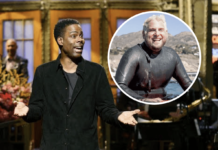Sexy VP “proud” to be endorsed by “America’s most
prominent living criminal.”
(Peter Maguire is BeachGrit’s occasional political correspondent
providing a lifetime surfer’s take on the machinations of power.
Beyond being a surfer, Peter is a war crimes investigator and
author of Thai Stick: Surfers, Scammers, and the Untold Story
of the Marijuana Trade, which Kelly Slater bought the film
rights for, Law and War – a book about the Nuremberg
Trials, Facing Death in Cambodia, Breathe, the bio on
jiujitsu icon Rickson Gracie and, released real soon,
its follow up Comfort in Darkness, “a
masterwork about the art of combat and the invisible powers within
us all.)
Why is Vice President Kamala Harris “proud” to have the
endorsement of Dick Cheney, America’s most prominent living war
criminal? I have devoted my entire professional life
to legal and historical accountability for atrocities, human rights
abuses, and war crimes and don’t make this accusation
lightly. In my expert opinion, Cheney’s war crimes stem from
his role as a principal architect of “the New American
Paradigm.“When someone shows you who they are,” Maya Angelou wrote,
“believe them the first time.”1

Days after 9/11, against the advice of many of America’s
military, foreign policy, and intelligence professionals,
Dick Cheney convinced President Bush to replace the Hague and
Geneva Conventions that govern U.S. soldiers’ battlefield conduct
and treatment of POWs, with the New American Paradigm.
On September 16, 2001, the Vice President unveiled his plan to
millions of television viewers on Meet The Press:
“We also have to work through—sort of—the dark side, if you
will. We’ve got to spend time in the shadows in the
intelligence world. A lot of what needs to be done here will have
to be done quietly, without any discussion, using sources and
methods that are available to our intelligence agencies, if we’re
going to be successful. That’s the world these folks operate in,
and so it’s going to be vital for us to use any means at our
disposal, basically, to achieve our objective.”
The Cheney‑led Bush administration replaced codified and
customary international law with new, elastic and ever‑changing
standards. Adversaries were redefined as “illegal enemy
combatants,” torture became “enhanced interrogation,” and
kidnapping “extraordinary rendition.”
Even though the U.S. Second Court of Appeals compared torturers
to slave traders in 1980, after 9/11 only those acts that resulted
in death or organ failure were considered torture. According to
this new definition, not even John McCain’s treatment at the hands
of the North Vietnamese met the Bush administration’s new
standard.
Since 2001, I have written and spoken out against “The New
American Paradigm.” I was never motivated by hatred for
the United States, or sympathy for fundamentalist Islamic
terrorists; in fact quite the opposite. I worried about
what would become of my country if we flouted the most basic norms
governing POW treatment and war crimes trials. “Although
military commissions have been used throughout American history,
given their uncertain historical legacy the president’s decision
raises as many questions as it answers,” I wrote in “Questions Hang
Over Military Tribunals,” a November 21, 2001, New York Newsday
op-ed. “Will ‘probative evidence’ in Bush’s military
tribunals include information obtained in [illegal] mock trials, as
done in many of the 1945 military trials?” The answer, I
would learn in late 2002, was a resounding “yes.”
After America consummated its sordid affair with Cheney’s “dark
side,” brazen disregard for the laws of war was elevated to a
matter of principle. By 2002, CIA paramilitary agents were
clandestinely transporting suspected terrorists to top secret
“black site” prisons outside the U.S. where they were tortured and
interrogated. Afterwards, evidence obtained by torture was
selectively leaked by the Bush administration to cabinet members,
favored politicians and handpicked reporters to justify their
actions.
During investigative trips to Cambodia in 2002–2003, I heard
credible rumors about “Cat’s Eye,” a secret American prison in
Thailand (also known as “Detention Site Green”) where CIA officials
were torturing and interrogating suspected terrorists.
The world would later learn that Abu Zubaydah was waterboarded
there eighty-three times in August 2002 alone. After al Qaeda
computer expert Abu Anas al-Libi was “rendered” to Egypt for
interrogation in 2002, he claimed under duress that Iraq was
training al Qaeda on the use of chemical and biological
weapons.
Secretary of State Colin Powell would repeat al-Libi’s lies in
his infamous 2003 UN speech that justified the invasion of
Iraq. Super-terrorist Khalid Sheikh Mohammed, “KSM,”
confessed to masterminding thirty al Qaeda operations and even
wielding the knife that decapitated Wall Street Journal reporter
Daniel Pearl after months of torture, interrogation and
isolation.

torture.

There was, however, one problem: evidence obtained by torture is
not reliable. A 2014 Senate Intelligence Committee report
concluded that Abu Zubaydah provided no new or significant
information. Even worse, the same committee concluded
that “the CIA’s use of its enhanced interrogation techniques was
not an effective means of acquiring intelligence or gaining
cooperation from detainees.”
Nonetheless, the Bush administration loudly declared the New
American Paradigm a great success. Over the course of the
next decade, fifty-four foreign governments aided and abetted
America’s torture and interrogation efforts. Some hosted CIA
black sites, others captured and transported suspected terrorists,
and still others turned a blind eye when their domestic airports
and airspace were used to transport prisoners secretly.3
By the time the United States invaded Iraq in 2003,
extraordinary rendition, secret prisons, indefinite detention of
American citizens, domestic espionage, and “watchlists” were all
accepted as facts of life by a stunned and submissive American
public who had the luxury of viewing the havoc wrought in their
name from afar. This arm’s-length relationship, however, was
shattered in 2004 when Army General Anthony Taguba’s report on
prisoner abuse at Abu Ghraib was leaked to investigative reporter
Seymour Hersh. Bin Laden himself could not have staged a more
successful propaganda coup as photographs of smiling, fresh-faced
American girls leading naked Iraqi men on leashes flashed around
the world in seconds.
One senior policymaker described the perpetrators to me at the
time as “the seven soldiers who lost the war.”
The Taguba Report exposed to the world that not just the New
American Paradigm, but also “torture’s perverse pathology,” had
taken root. Historian Alfred McCoy would later make the important
and overlooked point that torture doesn’t just fail to provide
reliable intelligence, it also “leads to both the uncontrolled
proliferation of the practice and long-term damage to the
perpetrator society.”
In just three short years, America’s use of torture spread from
a handful of CIA agents and military psychiatrists to common Army
reservists and unaccountable “defense contractors.”
Equally important, America, according to Secretary of Defense
Donald Rumsfeld’s own metrics, was now losing the Global War on
Terror (“Are we capturing, killing, or deterring and dissuading
more terrorists every day than the madrassas and the radical
clerics are recruiting, training, and deploying against us?”).
Overnight, the land of the free and home of the brave had been
transformed into the land of the surveilled and home of the
scared. Snitches, not truthtellers, were venerated and a
bovine body politic passively accepted the Patriot Act’s
unconstitutional overreach, the alphabet soup of new three-letter
government agencies whose cyber gaze was now focused on American
citizens, and the kangaroo courts that did their bidding.
After all, “if you’ve haven’t done anything wrong, you’ve got
nothing to be afraid of.”
During the early years of the Global War on Terror (2001-2005),
I regularly denounced the New American Paradigm on television,
radio and in New York Newsday.
I accepted long delays at airports because I “was on a list” and
was never surprised to find big, orange Department of Homeland
Security cards in my checked bags informing me that their minimum
wage mall cops had tossed my dirty clothes. When people
called me on my home phone and asked about the loud clicks, and
obvious, audible interference, I explained simply that “the
government is probably listening,” then added, “Fuck you, Alberto
Gonzales.”
I was more afraid of my great‑grandfather and PhD advisor
rolling in their graves for my failure to speak the truth than I
was of the U.S. government.
That said, after the Iraq invasion, my work became increasingly
lonely. People I once counted as allies succumbed to
various forms of pressure and got with the New American
Paradigm. As a result, I began to distance myself from them
and they began to distance themselves from me.
I was fortunate to have a small, but strong, support
system. People like criminal defense attorney Andy
Patel, laws of war professors Jonathan Bush and Gary Solis,
journalists Ed Vulliamy, my editors Peter Dimock and Leslie Kriesel
at Columbia University Press, Spencer Rumsey at New York Newsday,
and above all, my fearless Southern wife, Annabelle Lee, always
strengthened my resolve. There were still others—Senator Jim
Webb, Andrew Bacevich, Morris Davis—whom I did not yet know, but
whose willingness to speak truth to power, also inspired me and
reminded me that I was not alone.
Nobody, however, did more to strengthen my resolve
than Rich Arant. Like me, Arant had been very
actively involved with the war crimes accountability efforts in
Cambodia. Long before the UN swanned onto the scene and held
their imperfect and overpriced trials, the accountability efforts
were led by the Documentation Center of Cambodia (DC CAM).
Both Rich and I supported their efforts. While I
donated my research to DC CAM, Arant translated many of their
articles and books from Khmer into English.
Unlike me, Rich was not a civilian, but a slightly mysterious
military professional who had worked in Southeast Asia since the
end of the Vietnam War. By 2005, I had spent more than a
decade documenting Khmer Rouge atrocities, had interviewed many of
the former cadre who had committed them, and knew the inner
workings of Security Prison 21 (Tuol Sleng) as well as anyone in
the world.
Nevertheless Arant’s short, four-page untitled preface
to The Chain of Terror, a 2005 book about Khmer Rouge
secret prisons, forced confessions, and executions by
Cambodian author Meng-Try Ea, shook me to my core.
Arant wrote:
It was during 2002 that I first saw Meng-Try Ea’s draft
of The Chain of Terror in the Khmer language. The author
asked me to assist him with the English translation. Little did I
realize then how much this work would come to haunt me during the
next two years.
I recall as if it were yesterday sitting at a desk in the
Thai Armed Forces Intelligence Operations Center in Bangkok during
mid-1975 as a young Army NCO, reading the first Thai intelligence
reports of the barbarity that swept Cambodia. My immediate reaction
was that the reports were incredible, over the top. My assessment—
propaganda.
My experience a decade later as an Air Force human
intelligence officer interviewing inmates of communist prisons and
reeducation camps in Cambodia, Laos, and Vietnam had, I thought
hardened me to the cruelty of prisons and interrogations. More
recent memories of interviewing former Khmer Rouge cadre after the
United Nations brokered “peace” in Cambodia convinced me I knew
what evil these creatures, so unlike us, were capable of carrying
out in the name of “The Organization.”
Translating The Chain of Terror was a fascinating
opportunity to learn more about the evil perpetrated by
interrogators and guards inside prisons that operated far beyond
the pale of human decency. For months afterwards I would recall at
odd times one female witness’s description of the sounds of clubs
smashing the skulls of victims kneeling at the edge of freshly dug
pits, “the sounds of coconuts falling to the ground.”
Then late one night in early 2003 I found myself in the
“hard site” at Abu Ghraib, Saddam Hussein’s version of Pol Pot’s
S‑21, just a few yards from Saddam’s infamous death chamber, and
life changed forever. Standing there in shock, I recalled a phrase
from a Khmer Rouge interrogator’s notebook—”When the interrogator
is clear in his emotions and principles that the enemy arrested and
brought in by the party is a ‘spy,’ the interrogator can
successfully carry out his duty. Success is digging up the
mysteries hidden by the prisoner and demonstrating to the Party
that the prisoner was involved with the enemy.” Upper
echelon wanted answers and wanted them now. I soon left, ashamed at
being unable to perform my duty.
When I sat down my first “terrorist suspect,’” I began with
the question, “Why were you arrested?’’” Immediately I thought of
the testimony of one of the witnesses in The Chain of Terror:
“When I arrived at the interrogation room, the investigator told me
to sit down and began asking questions. The first question every
time was, “Do you realize why Angkar brought you here?”
Seldom does any interrogator really have any reliable
information about the prisoner who sits before him. The
interrogator must harden his heart sufficiently to act as if he
already knows the guilt is there, so he can apply the necessary
pressure to convince the prisoner that confession is the only
avenue out of a bad situation. Just part of the job, I told myself,
[but also remembering the witnesses whose testimony I had
translated quoting their interrogators:] “Angkar [The Organization]
has never made a mistaken arrest.’”
Arant’s preface continues:
Late one night during November 2004 at the American military
prison at Bagram Air base in Afghanistan, I stood in the
prisoner-in-processing room and listened to a young MP reading the
“house rules” to a just-unblindfolded and still trembling “Taliban
suspect.” The MP reads the rules verbatim from a sign posted on the
wall behind the prisoner’s back. My mind flashed to the Ten Rules
of Santebal [Special Security] written on the blackboard at Pol
Pot’s House of Horrors, S-21. Every prison has rules, I assured
myself.
I watched the stunned expression of newly arrived Afghans
and saw the same expressions once registered in the in-processing
mug shots taken at S-21. Exploiting “capture shock” is a necessary
part of the game. I told myself.
Ugly, but unavoidable.
As I questioned an Afghan prisoner accused by an unknown
paid informant of working against US forces, I went after the
identities of anyone he knew who was cooperating with the Taliban,
but was distracted by the recollection of Khmer Rouge interrogator
Pol telling his prisoner Sen: “Brother if you report the
secrets of the party: meaning you betray your party and join with
us, we will not be afraid to use you, But Brother, if you do not
report, that means you are stubborn and are protecting treasonous
forces.”
One night in the prison at Bagram I was interrogating an
older man, a man my own age, a former Mujahidin cadre who had
successfully fought with American support to drive the occupying
Soviet Army from his land. A former Afghan communist prison
commander, educated and trained by the Soviets, had recently taken
a security position with the new free Afghan government and
reported to US Forces that my prisoner was cooperating with the
radical Taliban mullahs.
My prisoner had been “implicated,” to use the Khmer Rouge
jargon. My prisoner had once been jailed by the Russians. I began
describing how the Khmer Rouge had turned on their own cadres and
tortured them to extract phony confessions, this during roughly the
same era when the Afghan jihad against the Russians was occurring.
I was preparing to make the point that he could trust an American
interrogator to treat him with more respect than the Russians had.
I was stunned to see this dignified man completely collapse in
tears, unable to speak. After my interpreter and I gave him a
chance to gather himself, he said, “I fought the Russians, our
common enemy, and now you Americans have imprisoned me on the word
of a son of the Russians. This is my reward.”
Since 2001, the words of American Nuremberg prosecutor Robert
Jackson’s opening address have haunted me. “We must never
forget that the record on which we judge these defendants today is
the record on which history will judge us tomorrow. To pass
these defendants the poison chalice is to put it to our own lips as
well.”
After 9/11, Dick Cheney transformed Justice Jackson’s poisoned
chalice into a poison keg. Not only did Bush, Rumsfeld,
Wolfowitz, Rice, Chertoff, Feith, Perle, Gonzales, Ashcroft, Libby,
Tenet and Black drink from it like frat boys during rush week, but
so did their eager pledges—Yoo, Addington, Hadley, Miller, Rizzo,
Sanchez, Bybee, Haynes, Goldsmith, Bellinger, Frum, and others.
.
Today, more than 23 years, eight trillion dollars, and a million
dead later, America has never been more insecure at home and had
less power, credibility and moral authority abroad.
“The U.S. is no longer the world’s policeman who will enforce
the international rules based order,” one dispirited government
official wrote me this year after the Biden administration
abandoned the 100 million dollar Airbase 201 in Niger. “We’ve
instead turned into the fat middle aged crossing guard, standing
there in a neon vest, flapping our arms and yelling at the side of
the road for cars to slow down.”
I once thought that the U.S.—Dakota War Trials (1862)
and the Yamashita case (1945) were the worst stains in
American international legal history. However, the Kafkaesque
farce that has dragged on for more than twenty years in Cuba, out
of sight and mind, at Guantanamo Bay, stands without parallel.
Instead of facing the fact that we have hit rock bottom and
ending the two decade-long bender, American leaders have unleashed
the New American Paradigm on U.S. citizens who dare question
whatever non‑oppositional ideology rules the day.
Because half of the country distrusts the Supreme Court and the
other half distrusts the Department of Justice, no matter who wins
this bleak election, the U.S. cannot move forward without some form
of reckoning. The neoconservatives who created this mess and
neoliberals who expanded and presently oversee it need to be held,
if nothing else, historically accountable. As for Dick Cheney,
although he will never wear headphones in the Hague, there is
nothing that can redeem him. If the former Vice President had a
sense of shame, he would join George W. Bush at his finger-painting
studio in Crawford, Texas and vanish from public sight.
Instead, Cheney continues to insert himself into American politics,
and it is up to us—democrats, republicans, progressives,
libertarians—to shun him like a racist uncle at Thanksgiving
dinner.
See my 2009 essay, “The New American Paradigm,” after the
Postscript below.
(This story appears on Pete’s
substack Sour Milk, subscribe, it’s free
etc.)
Endnotes
1. My great-grandfather, Robert Maguire, was a
judge at the final American trial at Nuremberg and one of my
dissertation advisors, Brigadier General Telford Taylor, was chief
prosecutor. Over the past thirty years, I have
investigated and documented war crimes, written books (Law and
War: Americans History and International Law and Facing Death
in Cambodia and articles about the experience, provided pro bono
advice to defendants, plaintiffs, governments, and NGOs in war
crimes and other high profile trials and investigations like
Extraordinary Chambers in the Courts of Cambodia 1997-2015;
David Irving v. Deborah Lipstadt/Penguin Books 2000; Donald
Rumsfeld v. Jose Padilla 2004; Kiobel v Royal Dutch Petroleum
Co. 2012; Investigation and arrest of Yan
Yoeun 2021; John Knock Presidential
Pardon 2021; Ann Shively and the estate of Michael Jay
Shively v. Utah Valley University, Astrid Tuminez, Karen Clemes,
and Sara Flood 2022.
2. Nations involved in the New American
Paradigm’s kidnapping and torture efforts included: Afghanistan,
Albania, Algeria, Australia, Austria, Azerbaijan, Belgium,
Bosnia-Herzegovina, Canada, Croatia, Cyprus, the Czech Republic,
Denmark, Djibouti, Egypt, Ethiopia, Finland, Gambia, Georgia,
Germany, Greece, Hong Kong, Iceland, Indonesia, Iran, Ireland,
Italy, Jordan, Kenya, Libya, Lithuania, Macedonia, Malawi,
Malaysia, Mauritania, Morocco, Pakistan, Poland, Portugal, Romania,
Saudi Arabia, Somalia, South Africa, Spain, Sri Lanka, Sweden,
Syria, Thailand, Turkey, United Arab Emirates, United Kingdom,
Uzbekistan, Yemen, and Zimbabwe.
3. Some of my more prominent stories:
“Questions Hang Over Military Tribunals,” New York Newsday, 2001;
“Our Standards of Judgment Are Whatever We Wish Them To Be” New
York Newsday, 2003; “Bush Can’t Have Justice Both Ways,” New York
Newsday, 2003; “The Undoing of International Justice,” New York
Newsday, 2004; “Here Comes the Judge: Hussein Trial May Set New
Low,” New York Newsday, 2004; “Look at Our Prisoner of War Policy
Now,” New York Newsday, 2004; “Soldier Serves as Scapegoat in Iraq
Scandal While Higher-ups Duck Responsibility,” New York Newsday
2005; “Padilla: US Courts Can Fight Terrorism,” New York
Newsday 2007; “UN-Cambodian War Crimes Court Is Tested,”
International Herald Tribune, 2009.
POSTSCRIPT:
When I wrote “The New American Paradigm” in 2009, I was working as
a defense contractor designing, testing, and building combat rescue
boats for the U.S. military.





